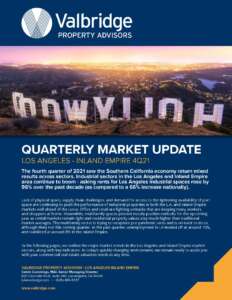4Q 2021: LA and Inland Empire
February 7, 2022
Government coronavirus restrictions are ending, and many companies are implementing back- to-work policies, but it’s not clear that workers are fully on board. Creative, collaborative spaces continue to be in demand, and conversions and adaptations are faring well across most sectors, although central business districts are still struggling.
Despite predictions about a massive drain in California’s population from urban centers, LA remains perennially among the top five metros in the country for venture capital investment. Education levels, while below the national average, improve every year. More people making six-figure paychecks continue to move to LA than are leaving on an annual basis. In the Inland Empire, Riverside County boasts the fastest growing population in the state, according to the most recent US Census data. Affordable (by Southern California standards, at least) housing draws residents, while exceptionally strong trade, transportation, and utilities sectors draw capital and investment. High-wage workers, however, find far fewer opportunities in Riverside and San Bernardino Counties (explaining, perhaps, their attractiveness to those who can work remotely).
Meanwhile, multifamily spaces present mostly positive outlooks for the upcoming year as rental markets remain tight and residential property values stay much higher than traditional market averages. The multifamily sector is trying to recapture pre-pandemic rates and is on track to do so, although likely not this coming quarter. In the past quarter, unemployment in LA leveled off at around 10%, and stabilized at around 8% in the Inland Empire.

Below, we outline the major market trends in four critical Los Angeles and Inland Empire major market sectors, along with key indicators, download the PDF. In today’s quickly changing environment, we remain ready to assist you with your commercial real estate valuation needs at any time.
LOS ANGELES INDUSTRIAL REAL ESTATE TRENDS
- The Los Angeles industrial sector has arguably the most sought-after warehouse space in the nation due to lack of available land and continuous backlog of cargo at the Southern California port complex, which handles 78% of West Coast container volume (and nearly a third of US total imports).
- Industrial flex properties had the highest vacancy rate of 5.4%,while logistics and specialized assets vacancy rates remain at 1.5%and 1.6% respectively – this is a consistent historical spread among subtypes and seems likely to persist.
- Metro rents increased by 10.4% year over year, compared to 8.6%nationally, and industrial rental rates in LA are up by a shocking 96.1% over the past decade.
- Investors have been increasingly aggressive in acquiring assets:the average market price surpassed $250/SF with several recent trades being well above that rate.
INLAND EMPIRE INDUSTRIAL REAL ESTATE TRENDS
- After a significant drop at the beginning of the pandemic, sales activity has consistently surpassed $1 billion for the past five quarters.
- Demand remains high:net absorption totalled 31.3 million SF over the past year, while rents have increased 11.9% over the same period.
- Over the past five years, rents increased by an aggregate of 54.2%.Areas near the Ontario Airport are especially popular right now, with both Amazon and FedEx investing heavily in infrastructure (withAmazon building a small fleet of aircraft, set to reach 200 planes over the next decade).
- One of the largest acquisitions of the past quarter was by Costco, fora1.6 million SF distribution center at $345 million, or $211/SF
LOS ANGELES OFFICE REAL ESTATE TRENDS
- The Los Angeles office space has shown little movement in the past quarter.Many investors continue their wait-and-see approach on the pandemic’s impact on office spaces.
- L.A. office vacancies continue to produce deteriorating results with a vacancy rate of 13.7%, the highest in 25 years.•Despite a previous negative outlook for the office sector,L.A. metro asking rates have maintained a stable $41.00/SF.
- Office spaces oriented toward the entertainment industry drive the most demand for L.A. office space leases, along with creative adaptive reuse projects.
- Sales are flat, too, with investors also waiting:office transaction volume during the past 12 months was at $4.6 billion, well below the market’s 10-year annual average of $7.2 billion.
INLAND EMPIRE OFFICE REAL ESTATE TRENDS
- The Inland Empire office sector remains stable. Limited development and population growth is projected to assist solidify market fundamentals during the upcoming year.
- Overall rents have grown by 3.3% over the past year with the majority of the gains coming from areas with access to freeways and neigh boring areas of Los Angeles and Orange Counties.
- The largest sales of late have involved small and mid-sized assets or offices occupied by government tenants.
- Cap rates have compressed in recent quarters, with an average market cap rate of 7.2%(vs the 10 year average of 7.4%
LOS ANGELES RETAIL REAL ESTATE TRENDS
- The Los Angeles retail sector had a rocky several quarters, but most retailers have adapted to multi-channel provision of goods and services; vacant big box stores or large retail spaces are attractive to redevelopers eyeing the industrial market.
- LA retail rental rates have declined since the beginning of the pandemic like the rest of the nation; although they remain 50%higher than the national average of $22.00 SF at $33.00 SF,LA lags other metro areas in retail rental rate recovery.
- Retail property sales rang up at $4.6 billion for the past 12 months, the highest in the nation- the market continues to draw investors.
- Average market cap rates at 5.4% are far below the national average of 7.0%
INLAND EMPIRE RETAIL REAL ESTATE TRENDS
- Many nationally recognized retailers (Nordstrom, Sears, etc) have been closing stores in the IE over the past several years, especially impacting big-box space.
- Leasing volume has returned to pre-pandemic levels in 2021 as many businesses view an improved economic outlook. Still, most leases signed recently involve small and mid-sized spaces.
- Rents have increased by 6.1% year over year, one of the fastest growth rates in the past decade.
- Market cap rates are holding high at 6.1%, outpacing SouthernCalifornia’s coastal markets, with properties often trading at a cap rate over 7%.
LOS ANGELES MULTIFAMILY REAL ESTATE TRENDS
- Rents recovered to pre-pandemic peaks in May 2021, whereas the nation achieved that milestone in January 2021, whereas the nation achieved that milestone in January 2021.
- Asking rents are presently increasing at a robust pace, and demand is strong, although state and local regulations place a ceiling on increases for landlords (AB 1482 keeps increases statewide to 5% plus inflation, while the LA County BOS implemented permanent rent control for unincorporated areas).
- Vacancies have come down to 3.6%with a recent demand for multifamily rentals in L.A. with net absorption of units running at its highest levels in years.
- Sales are also trending up, with average market cap rates at 4.1%, well above the U.S. average of 5.2%,
INLAND EMPIRE MULTIFAMILY HOUSING REAL ESTATE TRENDS
- The pandemic led to accelerated demand as renters sought apartments that are generally bigger with plentiful amenities in garden-style developments, all qualities of the newer developments dotting the landscape across Riverside and San Bernardino counties.
- Vacancy rates have fallen to 2.2%,and every submarket has vacancy below 3% except the Outlying Riverside County Submarket.
- Over the past 12 months, rents have increased by 14.4%,compared with the 10-year average of 5.4% per year.
- Cap rates continue to compress as institutional investors take advantage of low interest rates, but a consensus that the Fed will raise rates three times in 2022 could change the outlook
For more, including a deep dive into supply chain challenges, DOWNLOAD FULL REPORT HERE.


